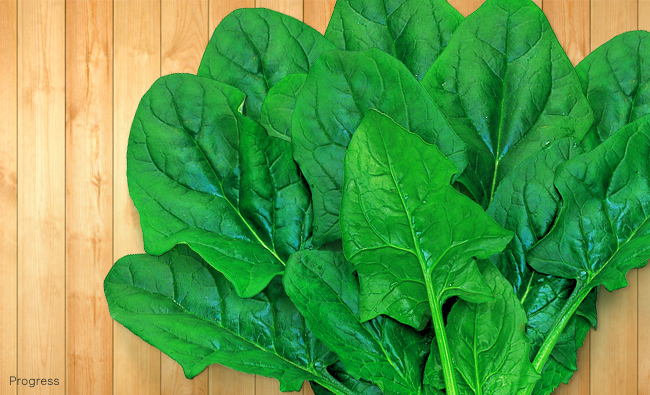- Top>
- Episode 04 Spinach

Episode 04 Spinach
King of leafy greens which fights against downy mildew
Spinach reminds us of Popeye. In a pinch, our hero downs a can of spinach and instantly becomes strong, allowing him to save Olive from Bluto. Although in reality no food obviously has such swift and dramatic effects on the body, spinach dose contain a large amount of vitamins A and C as well as iron, and is considered as the king of the brightly colored vegetables.
Spinach was introduced to Japan through China in the Heian period (early 9th century to late 11th century) and a local variety acclimatized to Japan started growing here. Becasue this local variety makes buds in long day conditions, spinach has traditionally been sown in autumn and harvested from late fall through winter in Japan and consumption has started to expand since the 1960s.
In the 1950s, cross breeding experienced significant growth partly because compared with hitherto cultivated varieties, high yielding spring and summer sowed varieties were developed. Of course the spread of television also contributed to this cause as children throughout Japan often heard their mothers repeating the refrain "Spinach will make you strong like Popeye."

Atlas

Downy mildew (face of leaf)

Downy mildew (back of leaf)
In 1972, Sakata Seed Corporation introduced "Atlas" spinach. This variety is an F1 hybrid, a blend of the European variety with rounded leaves and the Oriental type characterized by snicked leaf contours. From the European lineage, the variety acquired slow bolting properties (even in the long daylight hours days of spring and summer, flowers do not bud easily), downy mildew resistance, round shaped seeds and high productivity. From the Oriental type, it acquired the flavor, leaf shape, adaptability for winter harevest (it grows well even in low temperature environments) and resistance to soil borne diseases.
What was revolutionary about Atlas was its resistance to the serious downy mildew disease (race 1). Downy mildew is characterized by yellow specks on leaves and grey mould on the back of the leaves.
Spinach was no longer saleable when this disease manifested itself. Therefore, it was often necessary to spray fungicide in fall and spring. With "Atlas", however, disease free spinach could be obtained without using fungicides.
At that time, whether fields of Atlas spinach or fields of other varieties were affected by diseases could be easily known. Atlas seemed to have conquered the market. However, the downy mildew pathogen, like Bluto in the Popeye cartoons, challenged Atlas by continually posing a threat.
Within 10 years after Atlas was made available, a new strain of the disease, downy mildew (race 3) started infecting the spinach variety. In reaction to this, the "Solomon" variety, which was resistant to downy mildew race 1 and 3 was introduced and spinach could again be produced without such problems. However, within another 10 years, downy mildew race 4 which infected the Solomon variety occurred. After the introduction of the "Atlanta" and "Pandora" varieties in 1993, spinach could again be safely produced. However, after this was repeated several times, the "Progress" variety, which is resistant to downy mildew race 8, is on the market and being sold at present.

Solomon

Atlanta

Pandora

Progress
In Popeye's homeland, the USA, demand for spinach has increased dramatically over the last 20 years. With changing times, it is baby leaf products, not canned goods that are leading sales. Seeds are sown generously in the field, and when they reach the size of a spoon head, the plants are mechanically cultivated, cleaned, and packed. Sakata breeds varieties of spinach for baby leaf production and recent varieties are resistant to 13 strains of downy mildew, countermeasures against newly developing strains of downy mildew are required though, and the breeding process continues.




